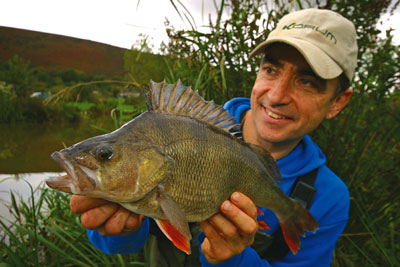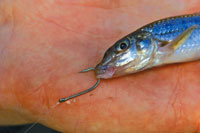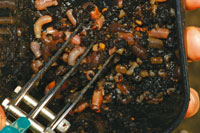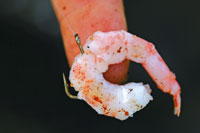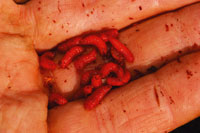The Pride Of The Valleys
Pics: Steve Martin
Pssst… Do you want to know a secret? Not many people know this. But there is something very special hiding away in your local stocked pool, something very special indeed. Now, with the nights drawing in, the leaves falling and the temperatures dropping it’s time to get out there and find out for yourself. It’s time for big perch!
Bold, bright and belligerent, ‘Old Stripey’ has had a chequered history as a species and not that long ago was almost wiped out by a bacterial ‘perch disease’.
How times have changed. The species is not only back but positively thriving, and there has never been a better time to bag yourself a real beast.
I’ve enjoyed some really special perch sessions on the rivers, including landing some whopping four-pounders on the perch Mecca that is the Great Ouse. But these days it’s commercial fishery perch that turn me on… so join me as I try to track down a real ‘day ticket dog’!
Commercial pools are the tops for serious bagging action, but most big-fish anglers tend to give them a wide berth, heading instead for more natural venues with a better specimen pedigree. But when you consider that the last two British record perch have been caught from commercials you realise they may be making a mistake.
In truth it’s no wonder perch thrive in commercial fisheries. There’s a massive head of silvers for them to feast on, no other predators to compete with (not many commercials hold pike by choice for obvious reasons) and with most anglers fishing paste, pellet, corn and boilies for carp, they have little chance of ever being caught!
Abundant food and a permanent angling amnesty provide the perfect recipe for growth and perch grow quickly, even in the smallest of pools – so don’t be put off by puddles!
If your local water ticks the right boxes you could be well on your way to earning your tcf Korum Challenge specimen perch badge!
For today’s session I’ve left the country! Travelling west through torrential rain and electrical storms I’ve made the Severn Crossing and headed through the valleys of South Wales. Heading further west towards Swansea and the Gower Peninsula I finally reach my destination, close to the village of Pontarddulais.
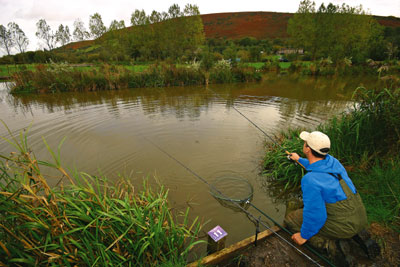 |
| White Spring Fishery – land of the giant perch. |
There, skirted by the River Loughor and in the shadow of the Cefn Drum hills, lies what has recently been voted the top day ticket stillwater in the UK. And as I gaze down the hill to the mature and beautifully landscaped complex of lakes I can begin to see why.
Before I can gather my thoughts White Springs fishery owner Vince Lloyd thrusts a steaming cuppa in my hands and brings me into the bar. Here is a man with passion for life and a passion for angling, and with his tales of giant perch ringing in my ears I can’t wait to make my way down to the lakes.
With most commercial venues on the small side, location is usually not too difficult. Perch are great lovers of cover, so any features, such as island margins, reeds or even underneath platforms, are worth exploring. On a barren fishery even the smallest of cover can harbour a big fish, so take advantage of whatever you can find.
Today I’m spoilt for choice. I’ve got islands in front of me, reed cover on the inside and some very sexy-looking bays and dark corners – all likely target areas.
To narrow the choices I’m going to spend the first hour wandering with a spinner and rubber jig. I might nick a bonus fish with these, but more often than not the perch will chase before shying off at the last second. What I’m actually looking for are plucks and follows. If I get the faintest indication of a take in a swim I’ll plot up there and fish it with other baits.
Sadly I’ve done a circuit and had nothing, so it’s down to watercraft!
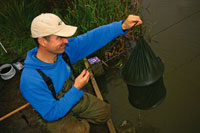 |
| Livebaits are kept fresh in this little net. Any not used are released after the session. |
I have spotted lots of carp activity around the islands so I’m going to steer clear of those and head for the largest area of reed on the fishery.
It’s only a couple of metres long and overhangs the water by just 60cm, but I reckon it’s enough, and if I sit well back and keep quiet I may just be able to nail one right in the edge.
In more natural waters perch will hold up in cover during daylight and ambush prey in the low light conditions that favour their superb eyesight. But on the coloured water of commercial pools they can strike at any time, so I’m keen to get baits out as soon as possible.
My perch kit is geared towards two things (see Perch Tackle panel). The first is versatility, as I may employ several different methods during the course of a session. Secondly it’s subtlety – perch have keen eyesight and are wary of undue resistance.
Although I’m keen to get my hook baits out my first job is to get a bit of bait into my margin spots. I’ve got 100 lobworms and a couple of pints of red maggots with me, and after a couple of minutes with a set of worm scissors I have a lovely ‘worm soup’ prepared. I’ll feed a small handful of chopped worm every hour to keep a worm scent around the reeds. In addition to this I will trickle red maggot in throughout the course of the session with a pinch every few minutes.
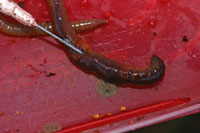 |
| Ian likes to pop up his lobworm bait by injecting the head with air and holding it down with a split shot. |
I opt for a little-and-often approach to keep the silver fish in my swim, but I don’t want too many going in as this may attract the carp. If carp muscle in I cut the feed entirely until they drift off.
With my target areas right in the margins I’m going to floatfish and I set up a couple of 4SSG Drennan loafers.
Perch will drop any bait if they feel a change in resistance, and a float allows me to eliminate this entirely and react immediately to the slightest dip or dither.
I’m fishing them paternoster-style (see rig diagram) with my rods in two rests pointing directly at the floats, again to minimise resistance.
Because the best perch fishing is at dusk and the first 30 minutes of darkness, I’ve adapted them to take a Betalite, which allows me to fish effectively through to the very end of the day (see panel).
Dusk almost always brings a furious but usually very short feeding spell and you must take full advantage of it.
In my experience if you net a fish you should unhook it, leave it resting in the landing net and get another bait out to the same spot as quickly as possible. You can sort out weighing and tidying up when the action is all over – just get that bait out again and chances are you’ll do the double.
A few minutes with the top three kit of my pole and I’ve got a stash of small roach, perch and gudgeon safely in my livebait net – perfect storage to keep precious baits in tip-top condition throughout a session. Let’s just hope the perch want them.
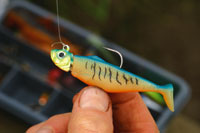 |
| tcf Top Tip Rubber jigs are used to locate perch but rarely catch the best fish. Once he feels a couple of plucks, or sees a quality fish follow his lure, Ian will try fishing in that spot with other methods. |
The rain has stopped, there’s cloud cover and I’ve got a good feeling about today. No dip. No preamble. The right-hand float buries and I’m into the first perch at 10am.
At around the pound mark it’s no monster, but a daylight fish is a bonus and with perch being a shoal fish I’m confident there will be more to come. Sure enough, an hour later the same float is away again.
This time there is serious resistance and with a massive shake of the head a big fish powers off toward the nearest island. Screaming clutch, rod bent: I know straight away it’s a lump. There are no pike in the fishery and it’s taken a perch livebait so it can’t be a carp. This is the real deal and my legs are like jelly as there’s no doubt in my mind that it’s a big fish!
I’ve never had a better fight from a perch and I have to confess to being a bag of nerves as it boils just out of reach of the landing net. tcf assistant editor Steve and I both clock the size of it and offer up a quick prayer. I parry one lunge to the reeds and then a second, but the clutch yields on the third dive and it has me snagged. Oh no!
No panic (or at least no obvious one!). I’ve kept a tight line and can feel the fish kicking. Steve volunteers to pull on his waders and go in, but I’ve one last card to play and, sitting down, manage to clear the top of the reeds with my legs.
The area under the floating reed raft is clear of snags and within seconds it’s game on! A minute later she’s in the net with my cry of joy echoing down the valley.
Just the right side of 4lb is more than I could have hoped for, especially with the best time of the day still to come, and when Vince arrives in my swim with a hot roast dinner a few minutes later I begin to think I’ve died and gone to some glorious perch heaven.
Fishing really doesn’t get any better than this. The afternoon brings further fish to 2lb 8oz and the dusk spell is a riot of activity including a couple of 3lb-plus specimens. What a session!
If you thought Wales was only famous for rugby, male voice choirs, sheep and Tom Jones then think again; White Springs and its perch really are the pride of the valleys.
Venue Fact File
White Springs Lakes, Garnswllt Road, Pontarddulais, Swansea SA4 8QG. Tel 01792 885699, www.whitespringsfishery.com
Ian’s Perch Tackle
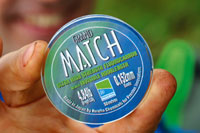 |
| Grand Match fluorocarbon is Ian’s hooklength choide for perch. |
Rod
This is the key to my versatility and a 12ft Korum Neoteric Float rod is the classic tool for the job. Being a two-piece rod I can break it down quickly and put it away without having to break down my end tackle, so I’m always ready to fish.
It’s also got a powerful action for bullying perch away from trouble – and they are notorious for diving into margin reeds and snags. Best of all it has the ability to double up as a light feeder or bomb rod, so I can easily swap between methods if conditions change without the need to carry extra rods with me.
Reel
My Daiwa Regal 3050BR is just the job for heavy float and light leger work.
Main Line
I use Reflo Powerline in 4lb 12oz (0.13mm). Subtle, but tough as old boots.
Hooklength
There is only one sensible choice for perch; with their excellent eyesight anything other than fluorocarbon puts you at a disadvantage. I opt for Grand Match in 4.8lb (0.152mm).
Hooks
Perch have large, tough mouths and I favour big baits so I’m looking for ironmongery that remains discreet even in sizes 4 and 6! My first choice is a size 6 Drennan Super Specialist.
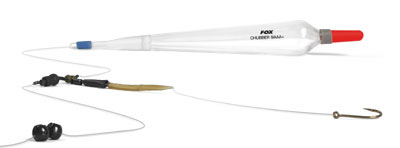
Baits For Perch
My perch fishing revolves around three hook baits; each has their day and where two rods are permitted I will look to offer something different on each. The fourth bait in my armoury is one I would not perch fish without – but would never use on the hook!
|
|
||||
|
|
Ian’s ‘Night Light’ Loafer
The domed top of a Drennan loafer is well-sized for a Betalite and I carefully drill out a hole in the tip with a bait drill. Using the drill as a ‘grater’ I then carefully enlarge the hole until I can just about ease a Betalite into it.
To finish off, and to ensure a permanent watertight seal, I secure the join between float and Betalite with a smear of Araldite (this is something to do at home well in advance of fishing because Araldite takes ages to dry off).
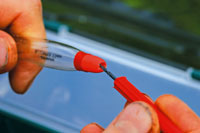 |
| Step 1 Drill a small hole in the top of the Drennan Loafer… |
 |
| Step 2 … until you can just about ease a Betalite into it and it holds in place. |
 |
| Step 3 The seal is made watertight with a drop or two of Araldite. |
tcf Advanced Tip
Perch are notorious for giving out post-capture signals which warn any other perch in the area of potential danger. Releasing one back into the swim you are fishing may signal the end of the action. Always use a keepnet or retention tube where permitted or, failing that, walk the fish in your landing net and release it as far from your swim as practical. It can make the difference between a one-fish catch and a real Red Letter day.
Tcf Top Tip
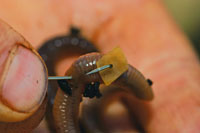 |
Livebaits and worms have a nasty habit of doing a Houdini, no matter which hook pattern you use – especially if rules stipulate you have to use barbless! To keep them on the hook Ian has several tricks up his sleeve. Firstly, livebaits are secured with a bright red Fox bait flag – this not only prevents them falling off but it also acts as a terrific sight target for a striking perch. Secondly, lobworms are kept in place with a red Enterprise Tackle rubber grub or, thirdly, a 5mm section cut from an elastic band. Try and wriggle out of that one!


